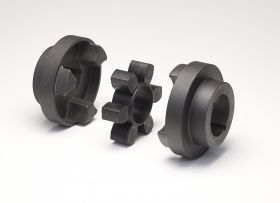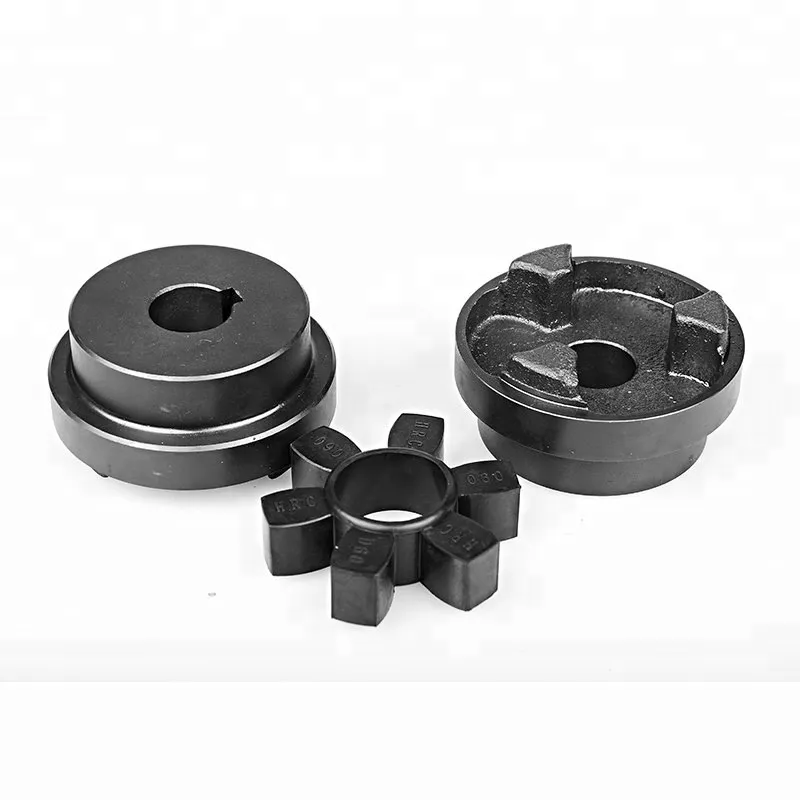Product Description
HRC Rubber Polyurethane PU Coupling Spider HRC70 HRC90 HRC110 HRC130 HRC150 HRC180 HRC230 HRC 280 Size
Product Description
- Installation is quick and easy without special tools required, only a hexagonal wrench is needed
- Maintenance is virtually eliminated without the lubrication required
- The electro-metric element allows HRC to be suitable for use in most conditions
- In the unlikely event of the flexible element being destroyed, the drive will be maintained by the inner action of the integrally cast driving dogs
Product Parameters
| Type F&H | Bored to size | A | B | E | F | G | L1 | L2 | L3 | J | ||||||||
| SIZE | BUSH | Bore | C | D | Bore | C | D | |||||||||||
| MAX MIN | MAX | MIN | ||||||||||||||||
| 70 | 1008 | 25 | 9 | 20.0 | 23.5 | 32 | 10 | 20 | 23.5 | 69 | 60 | 31 | 25 | 18 | 65 | 66.5 | 68 | 29 |
| 90 | 1108 | 28 | 9 | 19.5 | 23.5 | 42 | 10 | 26 | 30.5 | 85 | 70 | 32 | 30.5 | 22.5 | 69.5 | 76 | 82.5 | 29 |
| 110 | 1610 | 42 | 14 | 18.5 | 26.5 | 55 | 10 | 37 | 45.5 | 112 | 100 | 45 | 45 | 29 | 82 | 101 | 119 | 38 |
| 130 | 1610 | 42 | 14 | 18.5 | 26.5 | 60 | 20 | 39 | 47.5 | 130 | 105 | 50 | 53 | 35 | 89 | 118 | 146 | 38 |
| 150 | 2012 | 50 | 14 | 23.5 | 33.5 | 85 | 28 | 46 | 56 | 150 | 115 | 62 | 60 | 40 | 107 | 134 | 160 | 42 |
| 180 | 2517 | 60 | 16 | 34.5 | 46.5 | 80 | 28 | 58 | 70 | 180 | 125 | 77 | 73 | 49 | 142 | 165 | 189 | 48 |
| 230 | 3571 | 75 | 25 | 39.5 | 52.5 | 100 | 48 | 77 | 90 | 225 | 155 | 99 | 85.5 | 59.5 | 165 | 202 | 240 | 55 |
| 280 | 3525 | 100 | 35 | 51.0 | 66.5 | 115 | 60 | 90 | 105.5 | 175 | 206 | 119 | 105.5 | 74.5 | 208 | 247 | 286 | 67 |
Related Products
Company Profile
FAQ
Q: Can you make the coupling with customization?
A: Yes, we can customize per your request.
Q: Do you provide samples?
A: Yes. The sample is available for testing.
Q: What is your MOQ?
A: It is 10pcs for the beginning of our business.
Q: What’s your lead time?
A: Standard products need 5-30days, a bit longer for customized products.
Q: Do you provide technical support?
A: Yes. Our company has a design and development team, and we can provide technical support if you
need.
Q: How to ship to us?
A: It is available by air, sea, or by train.
Q: How to pay the money?
A: T/T and L/C are preferred, with different currencies, including USD, EUR, RMB, etc.
Q: How can I know if the product is suitable for me?
A: >1ST confirm drawing and specification >2nd test sample >3rd start mass production.
Q: Can I come to your company to visit?
A: Yes, you are welcome to visit us at any time.
Q: How shall we contact you?
A: You can send an inquiry directly, and we will respond within 24 hours. /* January 22, 2571 19:08:37 */!function(){function s(e,r){var a,o={};try{e&&e.split(“,”).forEach(function(e,t){e&&(a=e.match(/(.*?):(.*)$/))&&1
| Standard Or Nonstandard: | Standard |
|---|---|
| Shaft Hole: | Customized |
| Torque: | <10N.M |
| Samples: |
US$ 50/Piece
1 Piece(Min.Order) | Order Sample Two parts with rubber
|
|---|
| Customization: |
Available
| Customized Request |
|---|
.shipping-cost-tm .tm-status-off{background: none;padding:0;color: #1470cc}
|
Shipping Cost:
Estimated freight per unit. |
about shipping cost and estimated delivery time. |
|---|
| Payment Method: |
|
|---|---|
|
Initial Payment Full Payment |
| Currency: | US$ |
|---|
| Return&refunds: | You can apply for a refund up to 30 days after receipt of the products. |
|---|


How do HRC Couplings Compare to Other Types of Couplings in Terms of Performance?
HRC (Highly Resilient Coupling) couplings offer specific advantages and disadvantages compared to other types of couplings, making them suitable for certain applications while not ideal for others. Here is a comparison of HRC couplings with some other common coupling types:
- HRC Couplings vs. Flexible Couplings: HRC couplings and flexible couplings both provide some degree of misalignment compensation and damping of vibrations. However, flexible couplings typically offer higher torsional flexibility and better misalignment accommodation than HRC couplings. HRC couplings may have limitations in terms of angular and parallel misalignment compared to certain types of flexible couplings.
- HRC Couplings vs. Gear Couplings: Gear couplings are more robust and can handle higher torque capacities than HRC couplings. They are suitable for heavy-duty applications that demand higher torque transmission and greater misalignment accommodation. However, gear couplings may be more expensive and less forgiving in case of misalignment.
- HRC Couplings vs. Disc Couplings: Disc couplings offer excellent misalignment compensation and torsional stiffness. They can handle high-speed applications and provide precise torque transmission. However, disc couplings are generally more expensive than HRC couplings and may require more frequent maintenance.
- HRC Couplings vs. Jaw Couplings: Jaw couplings are simple and cost-effective but offer limited misalignment accommodation compared to HRC couplings. They are suitable for light to moderate loads and lower torque applications.
Ultimately, the choice of coupling type depends on the specific requirements of the application. HRC couplings are well-suited for applications where moderate misalignment compensation is needed, and cost-effectiveness is a consideration. They are commonly used in pumps, compressors, conveyor systems, and other industrial machinery.
When selecting a coupling, factors such as torque capacity, speed, misalignment requirements, environmental conditions, and maintenance considerations should be taken into account. It is essential to consult with coupling manufacturers or engineering experts to ensure the appropriate coupling is chosen for optimal performance and reliability in the given application.

What Role Does an HRC Coupling Play in Reducing Downtime and Maintenance Costs?
An HRC (Highly Resilient Coupling) plays a significant role in reducing downtime and maintenance costs in mechanical systems. Here’s how:
1. Vibration Damping: HRC couplings are designed with a flexible rubber element that acts as a vibration damper. The rubber element absorbs and dampens vibrations generated during the operation of rotating machinery. By reducing vibrations, the coupling helps prevent excessive wear and fatigue on connected equipment, such as motors, pumps, and gearboxes. This leads to less frequent breakdowns and extends the lifespan of components, ultimately reducing downtime for repairs and replacements.
2. Misalignment Compensation: As mentioned earlier, HRC couplings can handle various types of misalignment, including angular, parallel, and axial misalignment. By accommodating these misalignments, the coupling helps prevent additional stress on the connected shafts and bearings. The ability to handle misalignment reduces the likelihood of premature failures and breakdowns caused by misalignment-related issues.
3. Shock Load Absorption: In many industrial applications, rotating machinery may experience sudden shock loads due to various factors like sudden starts, stops, or changes in load. The flexible rubber element in the HRC coupling acts as a shock absorber, cushioning the impact of these sudden loads. By absorbing shock loads, the coupling protects the connected equipment from damage and minimizes the risk of unexpected downtime due to shock-related failures.
4. Easy Installation and Maintenance: HRC couplings are relatively easy to install and maintain. They do not require complex alignment procedures, and the flexible element eliminates the need for lubrication. The simple design and ease of maintenance contribute to reducing the time required for installation and upkeep, thus lowering overall maintenance costs.
5. Cost-Effective Design: HRC couplings are cost-effective compared to some other types of couplings. They provide reliable performance and durability at a reasonable price point. The cost-effectiveness of HRC couplings makes them a popular choice in various industrial applications where reducing operational costs is a priority.
Overall, the HRC coupling’s ability to dampen vibrations, compensate for misalignment, absorb shock loads, and offer easy installation and maintenance translates into improved reliability and efficiency of mechanical systems. This, in turn, leads to reduced downtime and maintenance costs, making HRC couplings a valuable component in power transmission applications across industries.

Explanation of Different Types of HRC Coupling Designs
1. HRC Standard Design: The standard or classic HRC coupling design consists of two cast iron hubs with a spider made of an elastomeric material, usually rubber. The hubs have teeth on the inner surface that mesh with the spider, providing torque transmission and flexibility. This design is commonly used in various industrial applications due to its simplicity and cost-effectiveness.
2. HRC Spacer Design: The HRC spacer coupling design is similar to the standard HRC design, but it includes a spacer between the two hubs. The spacer allows for more axial misalignment compensation and can accommodate longer distances between shafts. This design is suitable for applications where additional spacing between the shafts is necessary.
3. HRC Flywheel Design: The HRC flywheel coupling design is specifically used in applications where the coupling is mounted on a flywheel. The design incorporates a flywheel mounting hub on one side and a standard HRC hub on the other side. This allows the coupling to be easily connected to a flywheel for various engine-driven machinery.
4. HRC Taper Lock Design: The HRC taper lock coupling design includes taper lock bushings that enable easy installation and removal of the coupling from the shaft. The hubs have a tapered bore, and the taper lock bushings are inserted into the bore, providing a secure and precise connection to the shaft. This design is commonly used in applications that require frequent coupling removal and reassembly.
5. HRC Brake Drum Design: The HRC brake drum coupling design is used in applications where a brake is required. The design incorporates a brake drum on one of the hubs, allowing the coupling to serve both as a torque transmitting coupling and a brake drum for braking purposes. This design is commonly used in industrial machinery where controlled braking is necessary.
6. HRC Non-Spacer Design: The HRC non-spacer coupling design is similar to the standard HRC design but does not include a spacer. This design is suitable for applications where the shafts are relatively close together, and a spacer is not required for additional misalignment compensation.
7. HRC Stainless Steel Design: The HRC stainless steel coupling design is used in applications where corrosion resistance is essential. The hubs and spider are made of stainless steel, providing better resistance to rust and corrosion. This design is commonly used in industries such as food processing, marine, and pharmaceuticals.
8. HRC Pilot Bore Design: The HRC pilot bore coupling design is supplied with plain bore hubs, allowing the end-users to machine the bore to the required size. This design is beneficial when the shaft sizes are not standard or need to be customized for a specific application.
Overall, these different HRC coupling designs offer flexibility and versatility to suit various power transmission requirements across different industries.


editor by CX 2024-04-19
by
Leave a Reply